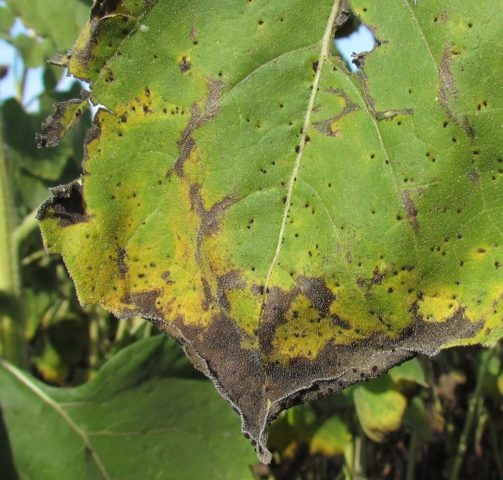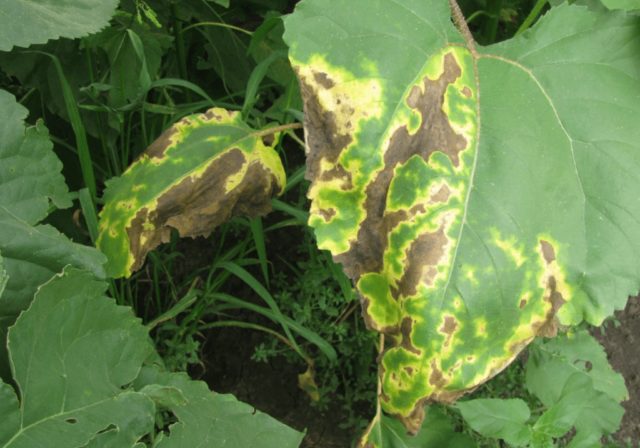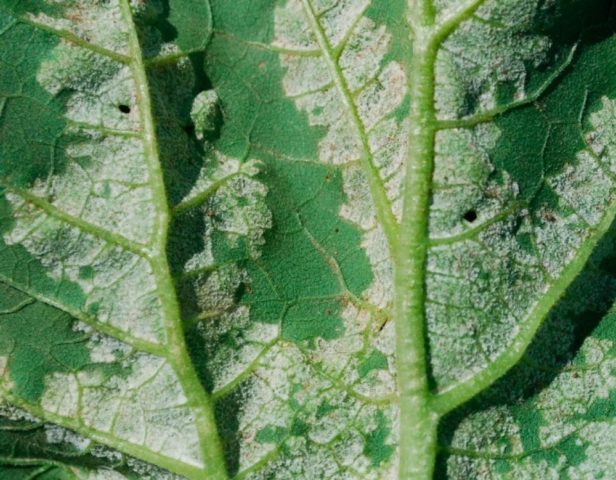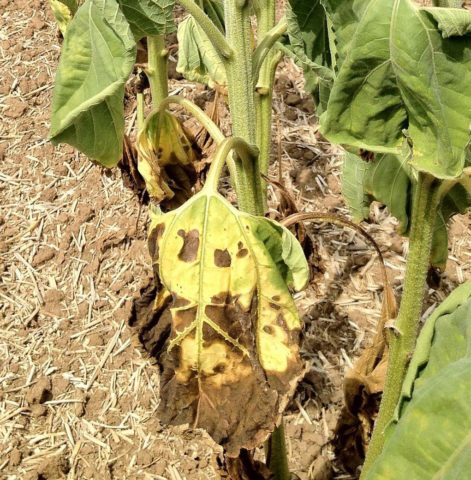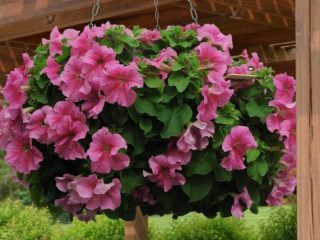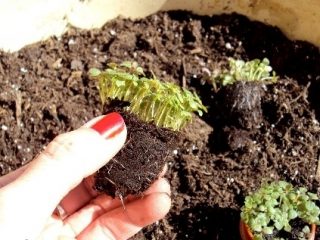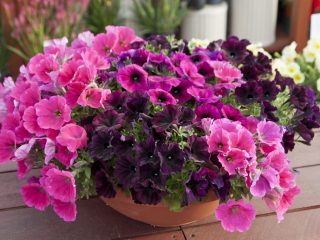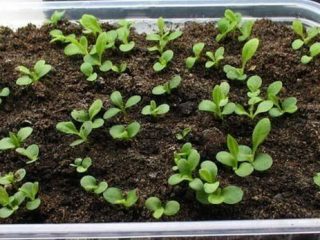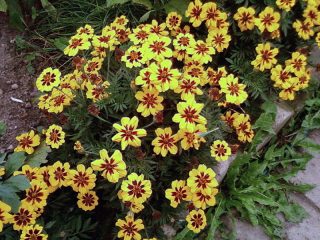Content
Sunflower Teddy Bear is one of the most popular and favorite varieties of decorative helianthus by flower growers. Its large double inflorescences resemble soft fur pom-poms of yellow-orange color, and the green foliage of low, but dense bushes harmoniously emphasizes the brightness of flowering. Sunflower The bear cub looks great in small and large groups in flower beds and in flower beds, it is often grown in containers. Fluffy "suns" on strong stems look spectacular when cut in bouquets. It is an annual, but its seeds are easy to collect and germinate next year. It is enough to plant the plant in fertile soil in a sunny place and provide simple but competent care so that the sunflower, which looks like a cute teddy bear, feels great in the garden, inspiring and giving a good mood until the frost.
Description of decorative sunflower Teddy bear
Ornamental annual sunflower Bear cub is known in foreign sources under the names Teddy Bear and Dwarf Sungold. In Russian-language descriptions, this variety is often called Teddy Bear, Teddy Bear, Teddy Bear, Teddy Bear.
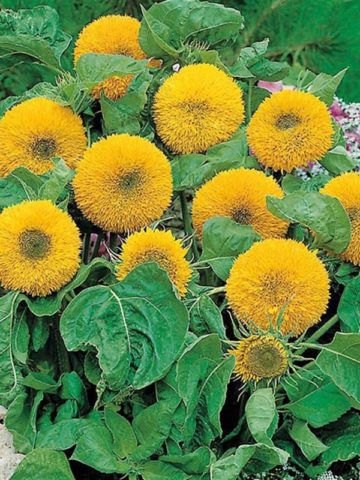
Teddy Bear or Teddy Bear - a short terry variety of an ornamental annual sunflower
It belongs to low helianthus - according to various sources, its height ranges from 40 to 90 cm. Stems are erect, strong. From the central shoot of the sunflower, the Bear cub branches off several lateral ones. One plant usually grows up to 30-60 cm wide.
The large leaves of the bear cub sunflower are colored dark green. They are dense and smooth to the touch, oval or heart-shaped in shape.
A large number of buds and inflorescences are formed on each plant. The average diameter of the opened flower is from 10 to 20 cm. The bear cub is a densely doubled sunflower variety. Its bright yellow or yellow-orange flowers resemble fluffy balls, the numerous petals of each of which carefully cover a small greenish core.
Photo of a sunflower A bear cub in a flowerbed fully allows you to imagine how decorative and effective this variety is at the height of the flowering period, which begins in mid-summer and usually lasts until October.
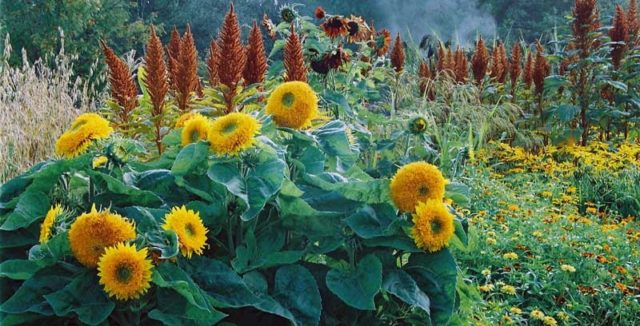
Sunflower Bear is very much loved by landscape designers and florists
The seeds in the baskets are fully ripe after flowering. They are characterized by a dark gray, almost black color, oval shape and small size (only about 0.5 cm). They are easy to collect after the inflorescences are completely dry, and germinate again the next year.
When to plant sunflower seedlings Bear cub
Growing the sunflower Bear cub from seeds by the seedling method begins in March-April, about a month before the last frosts finally stop.
Prepare small, clean, individual containers with sufficient holes in the bottoms for drainage.You can fill them with a ready-made universal substrate for seedlings or soil from the site - nutritious and loose, with neutral acidity. Next, in each pot you need to sow 2-3 sunflower seeds Bear cub and carefully deepen them by 1.5 cm. At first, the crops are covered with film or glass.
After the emergence of shoots, one of the strongest sprout is left in each container. They are watered sparingly, making sure that the soil remains moist, and kept at room temperature in a sunny southern window (or supplementary lighting is arranged). It is advisable to start hardening sunflower seedlings Bear cub as early as possible.
At the end of May and at the beginning of June, the seedlings, together with an earthen lump on the roots, are transplanted into an open area, maintaining a distance of 45-60 cm from each other. In the future, they are looked after in the same way as young seedlings.
Planting and caring for sunflowers Bear cub
Most often, the bear cub sunflower is sown directly into the ground, without wasting time and effort on the seedlings. The optimal time for this is considered May and early June, when the soil in the garden warms up sufficiently, and the threat of return frosts has finally passed.
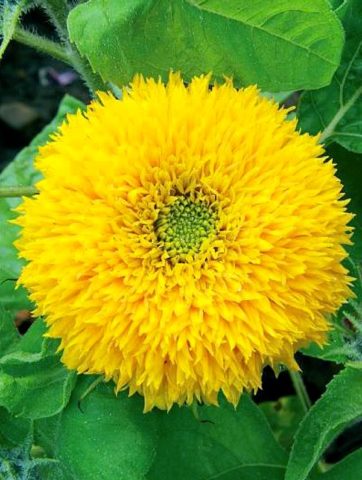
Sunflower inflorescences Bear cub resemble fluffy fur pom-poms
Selection and preparation of the landing site
The plot for growing sunflower Bear cub must be prepared in advance, at least one month before the intended planting of seeds, and best of all - from the end of the previous season. It should be removed, cleared of litter and plant debris, and then dug up to 25-30 cm in depth, while simultaneously applying organic fertilizer or leaf mulch. Heavy, clayey soil can be thinned with sand at this stage.
The area where the decorative sunflower Bear cub will feel good should be:
- sunny;
- protected from the wind;
- have a light, nutritious soil with a neutral reaction and low salt content.
Landing rules
Before planting sunflower seeds, Bear cub is recommended to prepare: soak for 1 day in water with the addition of a fungicide or in a weak solution of potassium permanganate to develop resistance to pests and diseases. It is also advised to dissolve 1 tbsp. l. wood ash in 0.5 liters of water, wet a piece of cloth in the resulting composition and, wrapping the seeds in it, stand for 24 hours (if the cloth dries up, it should be moistened again).
Then you can start sowing sunflower seeds Teddy bear in the ground:
- dig shallow grooves or individual holes on the site;
- put 2-3 seeds in each hole or on one planting site in the groove, deepening them by no more than 1.5 cm;
- carefully roll up the crops and moisten the soil (but do not flood it).
The first shoots can usually be seen within a week. After two pairs of true leaves appear in young sunflowers, the planting should be thinned out, leaving the strongest specimens at a distance of 45-60 cm from each other.
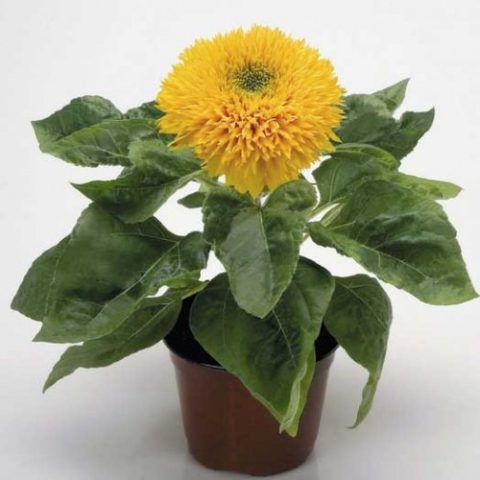
Sunflower Bear cub can be grown both in the garden and at home in a pot
Watering and feeding
Despite the fact that the sunflower Bear cub can safely tolerate a short-term drought, you need to remember that this plant is moisture-loving. Lack of water will negatively affect the number and size of flowers, therefore, gelianthus should be watered regularly, about 1 time per week, and more often if necessary. Water must be poured at the root, making sure that the soil does not dry out, but also preventing it from swamping and dampness.
If the soil is nutritious enough, then the Bear cub sunflower does not need additional feeding. Having a soil poor in composition, you can do this:
- a month after the crops sprout, feed them with nitrogen-containing fertilizers;
- at the stage of the appearance of buds and during the flowering period, add potassium-phosphorus or complex mineral compositions.
In addition, it is important to promptly weed out the weeds on the site, as well as regularly remove the baskets that have faded.
Compliance with these simple measures will allow the sunflower Teddy bear to show itself in all its glory in the front garden, in the country or in the garden, and look as shown in the photo:
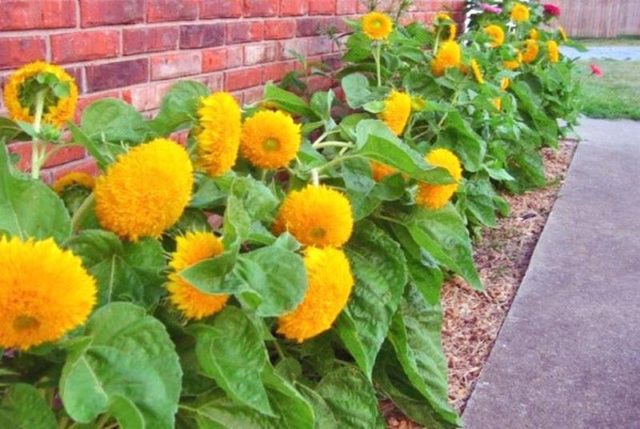
Decorative borders near the walls of buildings and along garden paths are a great idea for using a sunflower Bear cub to decorate the site
Reproduction
It is not difficult to collect sunflower seeds on your own. The heads from which the seed is supposed to be obtained must be allowed to completely bloom on the bush, waiting for them to dry. In order to prevent the seeds from becoming prey for birds, it is advisable to protect them by tying the selected sunflower baskets Teddy bear with a piece of light mesh or gauze.
After the heads have faded, you must carefully cut them off at the base with a sharp knife, lay them out on a tray or flat tray and allow them to air dry well. Next, you can store the seeds right inside the baskets, or you can gently release them, fold them into a paper or linen bag and leave in a dry, dark place until next season.
Diseases and pests
Proper care contributes to the fact that the decorative helianthus grows beautiful and healthy, without suffering from ailments. At the same time, it will not be superfluous to get acquainted with the description and photo of some diseases that can harm the sunflower Bear cub, in order to be able to identify them in time and help the plant:
- Dark brown spotting (Alternaria). Can affect sunflowers growing both in the garden and in the room by the window. The disease develops rapidly at high air temperatures in conditions of high humidity. Chaotically located ash-gray and black spots appear on the leaves and stems of the sunflower Bear cub, which gradually merge, increasing in size. The affected organs die off quickly. The diseased parts of the plant should be removed with sterile instruments and burned, and the air humidity should be reduced. Sunflower A bear cub growing in a room should be isolated from other plants. Mass plantings on the site need to be treated with antifungal drugs (Bakhmut, Rovral).
Alternaria on sunflower appears as gray and black spots on the leaves
- Verticellosis wilting. Sunflower leaves Teddy bear lose their elasticity and brightness. Subsequently, brown dying areas are formed on them, along the edge of which a yellow border can often be seen. Affected plants should be destroyed and no more sunflowers. Bear Cub in this area. For preventive treatment, the preparations Gamair and Alirin-B are suitable.
Infection with verticellosis may be indicated by dying leaf areas, framed by a yellow border.
- Downy mildew (downy mildew). It appears on the surface of sunflower leaves in the form of spots of a whitish color, and on the back of them you can see a bloom of off-white color. If possible, it is advisable to remove diseased plant organs and provide the plantings with good ventilation, thinning them if necessary. Treatment with Previkur, Copper Oxychloride or Ridomil Gold is effective.
Downy mildew often affects thickened sunflower plantings
- Fomoz. The appearance on the leaves of the sunflower Bear cub spots of red-brown and dirty-brown color. The affected green mass withers and dies, and the disease quickly spreads to the stems and baskets. Treatment of sunflower Bear cub during the growing season with fungicidal preparations (Derozal, Impact-K) can help. Prevention is the observance of correct agricultural techniques.
Phomoz contributes to the rapid death of the green mass of sunflower
A common parasite that damages sunflower is the broomrape (top). This flowering plant lacks its own root system. It settles on the roots of the sunflower, suppressing it and helping to weaken the immune system. Pre-sowing "provocative" crops (clover, rapeseed, alfalfa) one year before the sunflower Bear cub can help. They promote the germination of broomrape seeds, but are not the owners of the plant. It is also necessary to dig the soil thoroughly and deeply. Affected specimens should be removed along with the root and parasites growing on it.
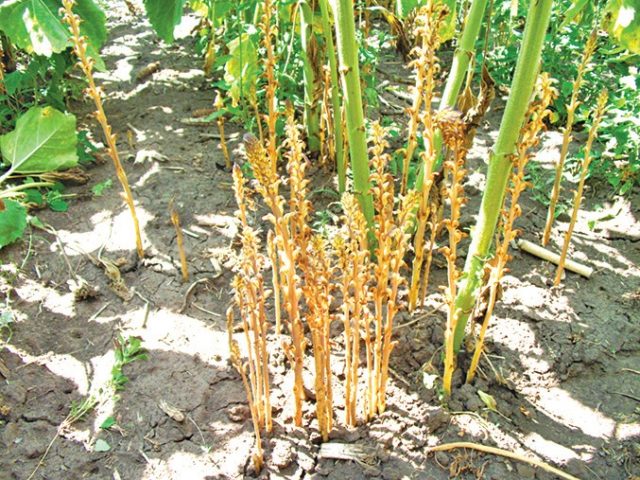
Broomstick, or spinning top, is a flowering plant parasitizing sunflower
Of the insect pests that can attack the sunflower Bear cub in the garden, aphids are most often encountered. The leaves of the plant, from which the insect colonies drink juices, quickly curl up and turn yellow, the buds do not open. For small foci of infection, spraying the plantings with soapy water can help. If the lesion is massive, then you should resort to potent drugs (Akaverm, Aktellik, Biotlin, Fitoverm, Decis, Iskra, etc.)
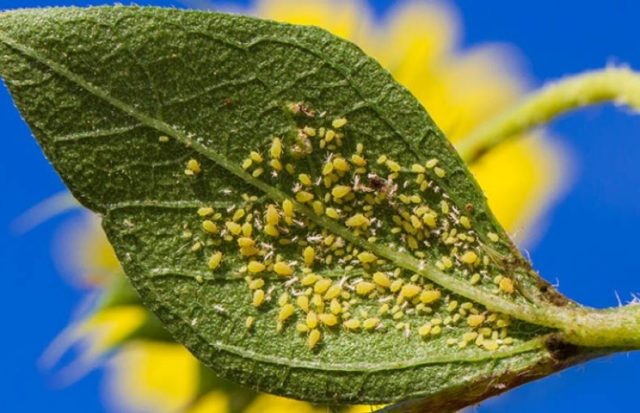
Aphid colonies on sunflower feed on plant juices, which is why its leaves curl and turn yellow
Conclusion
Sunflower Bear cub is a well-known variety of the ornamental annual helianthus, which blooms very beautifully and brightly. During the flowering period, which lasts from mid-summer to October, the low, but dense shoots of this plant are strewn with large spherical double inflorescences with golden petals. Like most ornamental helianthus, the sunflower Teddy Bear does not need complicated care, it has enough space on an area with fertile soil, good sunlight and timely watering. The beauty and unpretentiousness of this annual will surely be the reason why a florist who sowed it in a flower bed once will not want to part with it for future seasons. In this case, you can easily collect its seeds and grow the Bear Cub sunflower again next year.
